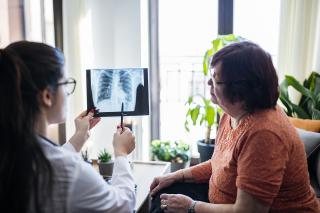If you want to breathe easy, you might want to brush up on the latest lung cancer statistics. Because lung cancer accounts for a staggering 25% of all cancer deaths, it’s important for Americans to understand if they’re at risk and how to detect any issues early. Here’s everything you need to know.
Current Lung Cancer Statistics
- Nearly 236,740 people will be diagnosed with lung cancer in 2022 in the U.S.
- Lung cancer accounts for 25% of all cancer deaths.
- 1 in 16 people will be diagnosed with lung cancer in their lifetime–1 in 15 men and 1 in 17 women.
- Half of the women diagnosed with lung cancer (50.1%) will survive just one year. Only one in 5 of those women who are diagnosed with lung cancer (22%) will survive five years.
- Early-stage detection of lung cancer is when the disease is most treatable, and only 16% of the eligible population will be diagnosed at an early stage.
- Lung cancer symptoms include changes in mucus, chest or back pain, coughing up blood, and difficulty swallowing.
Thankfully, the number of new lung cancer diagnoses is declining steadily.
From 2009-2018, the frequency rate decreased by 2.8% per year in men and 1.4% per year in women. Further, lung cancer deaths have been cut by more than half for men and by a third for women. Thankfully, reductions in smoking largely account for the steady decline in cases and deaths.
Are You At Risk For Lung Cancer?
The most common cause of lung cancer is smoking. However, smoking is not always a prerequisite. In fact, people who never smoked account for 20% of lung cancer deaths, with an estimated 47,300 nonsmokers slated to be diagnosed with lung cancer by the end of 2022.
How do nonsmokers get lung cancer? The short answer: Exposure to other people’s smoke (second-hand smoke), a family history of lung cancer, and environmental pollution are to blame.
Before 2009, when restaurants and other public establishments banned smoking in public places indoors, nonsmokers were regularly exposed to higher levels of second-hand smoke than today. But while smoking and exposure to second-hand smoke are the most common causes of lung cancer, these critical factors also elevate your risk for lung cancer:
- Radon. Radon is an invisible, odorless, and tasteless radioactive gas that occurs naturally in soil and rocks. The Environmental Protection Agency (EPA) suggests testing the soil on your property as an easy and inexpensive way to reduce exposure. Exposure to radon gas is the second leading risk factor for lung cancer.
- Age. Increasing age is a risk factor for many cancers, including lung cancer. The average age in the United States for a lung cancer diagnosis is around 70 years of age.
- Family history. Studies suggest that adults who have or had a fully related parent or sibling with lung cancer, especially one diagnosed before age 50 or with multiple relatives diagnosed, are at increased risk for lung cancer.
Lung Cancer Prevention Tips
Lung Cancer screening is completed through testing using low-dose computed tomography, also known as low-dose CT (LDCT). This form of screening can identify small nodules or other lung abnormalities. Finding a problem early, before any symptoms, may make treating it easier.
You should be screened if:
- You are between the ages of 50-80
- You are a current smoker or quit within the past 15 years
- You have a 20-pack-year smoking history
A 20-pack-year smoking history refers to the number of packs smoked per day multiplied by the number of years of smoking. For example, 1 pack per day X 20 years = 20 pack years.
The Benefits of Routine Lung Cancer Screening
Considering all the benefits and risks of lung cancer screening is critical. Here are some other important things to consider:
- Screening is not a one-time test. For it to work, you must get screened yearly for as long as your doctor recommends. This allows any cancer that may be small and growing slowly to be found as early as possible.
- If you smoke, it is still important to consider quitting. You might think it doesn’t matter, but quitting has many benefits, even now. Your healthcare team wants to help you! Don’t be afraid to ask for their help. After your screening, the results will be sent to your doctor. Your doctor will review the results of the scan and will discuss if any follow-up is needed.
Lung Cancer Treatment Options
If you are diagnosed with lung cancer, there are several options for treatment. Consult your doctor to determine the best treatment plan for you. These may include:
- Chemotherapy
- Radiation
- Immunotherapy
- Surgery
- Targeted Therapy
- Ablation Therapy
There is Hope
Early detection of lung cancer is possible through appropriate screening and treatment, if necessary. Receiving the appropriate screening can detect lung cancer early and provide you with an improved quality of life by catching problems before they get worse. Schedule your screening today! Find a center near you.




